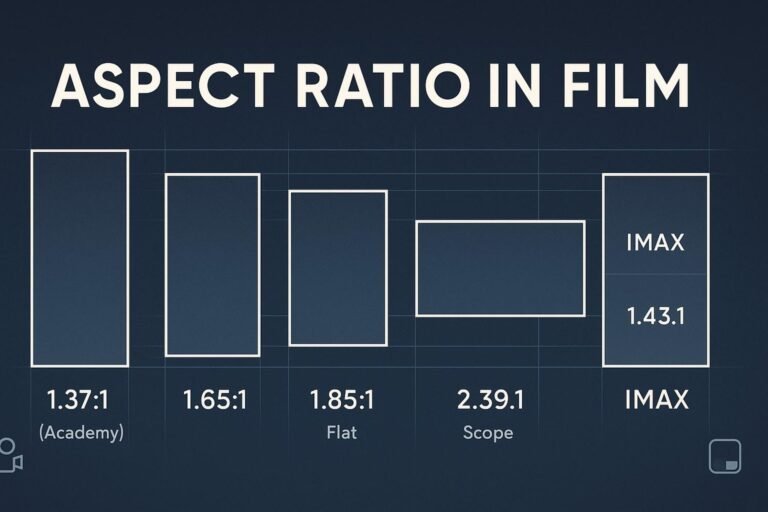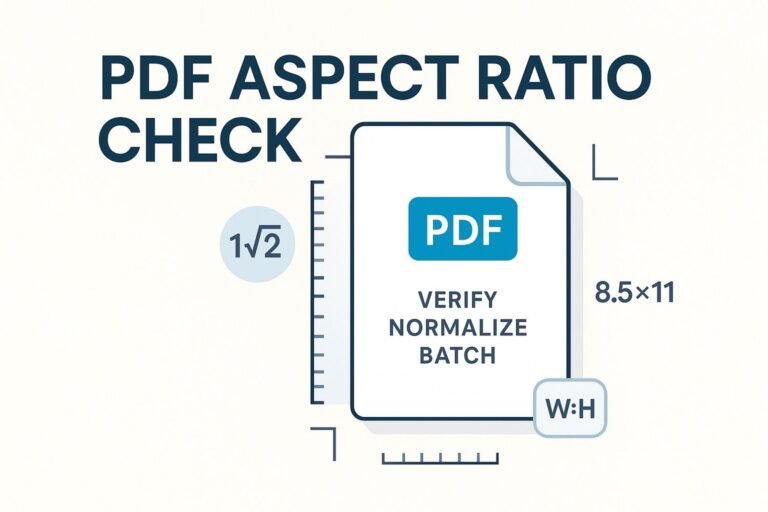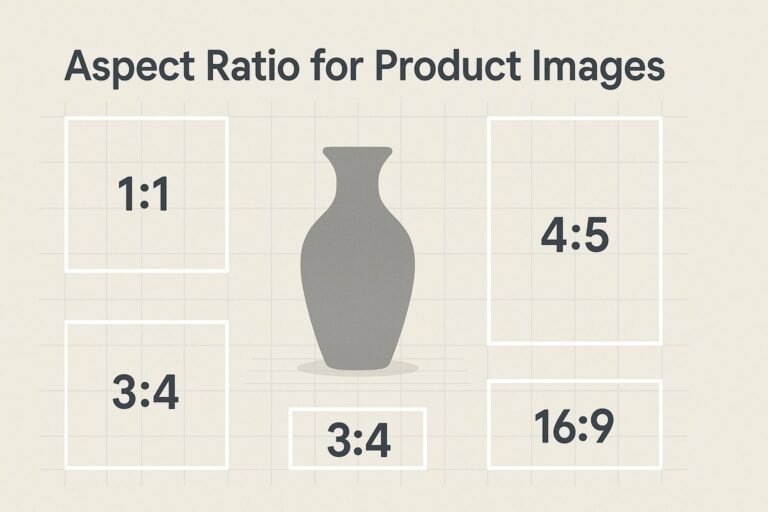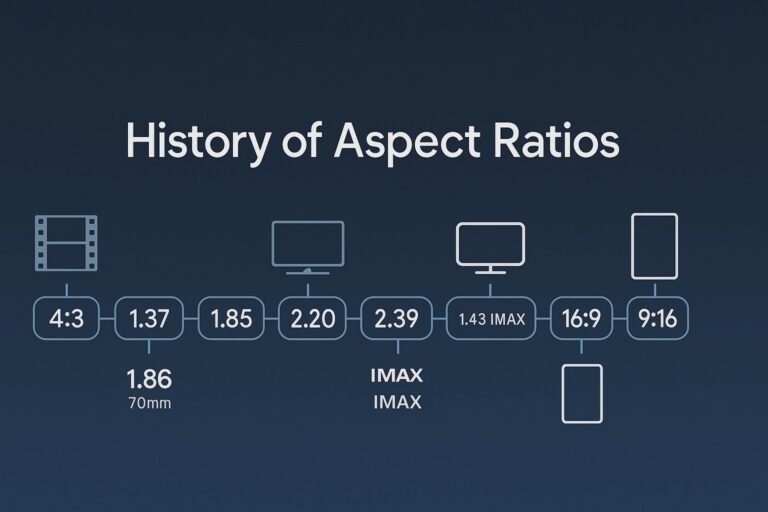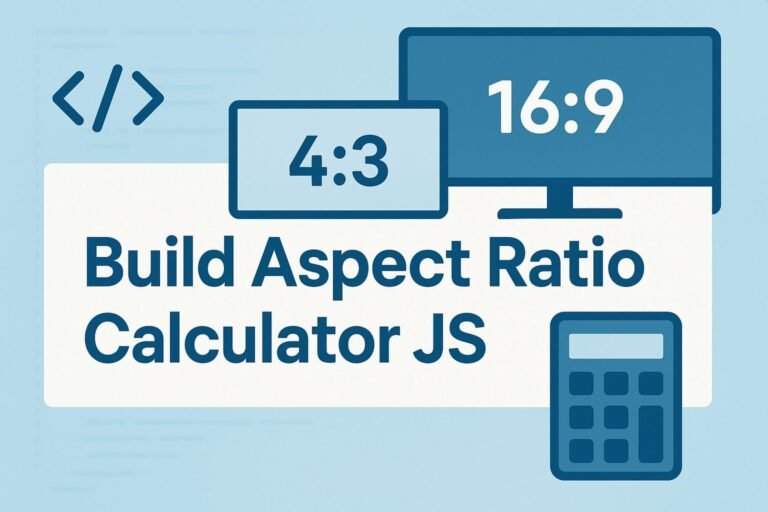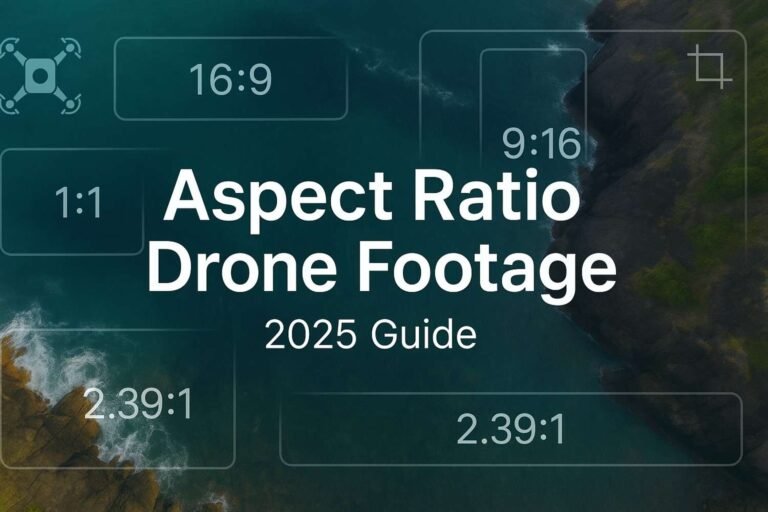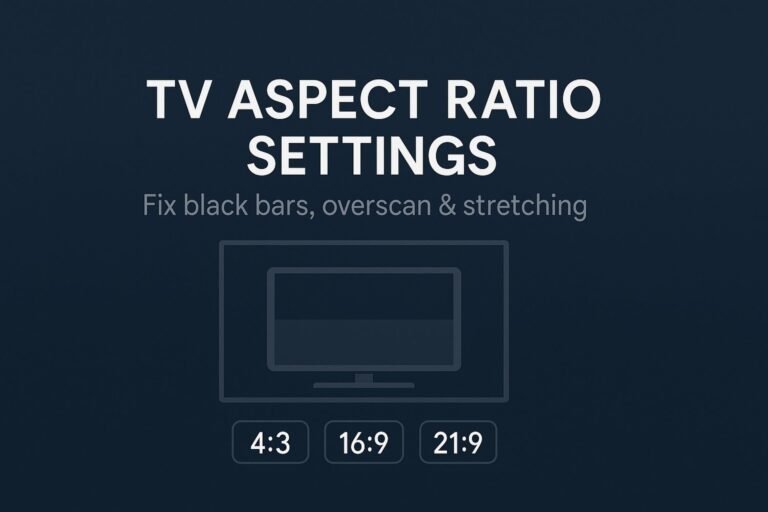Choosing the right aspect ratio in film shapes how audiences feel your story. This guide explains the history, aesthetics, and workflows behind the most common ratios—so you can pick the perfect frame with confidence.
Quick Answer
Aspect ratio is the relationship between image width and height (e.g., 2.39:1, 1.85:1, 1.37:1). For a sweeping, panoramic feel, pick 2.39:1 (scope). For a versatile “cinematic” frame that favors faces and dialog, choose 1.85:1. For intimacy or retro vibes, consider 1.37–1.66. For premium large-format spectacle, IMAX uses 1.90:1 (digital) and up to 1.43:1 (15/70 film). Make the decision based on theme, blocking, locations, lenses, and distribution.
What Is Aspect Ratio in Film?
Aspect ratio in film defines the “shape” of your frame. It influences composition, lens choice, how you stage actors, and even where titles and captions can live. It’s written as width:height—so 2.39:1 means the image is 2.39 units wide for every 1 unit tall.
Why Aspect Ratio Matters for Story & Audience
- Psychology of space: Wider frames celebrate geography, ensembles, and visual counterpoint; taller frames highlight faces, verticality, and confinement.
- Genre expectations: Scope often reads as “epic”; 1.85 is naturalistic; 1.37 can feel period, diaristic, or claustrophobic.
- Platform reality: Theaters prefer 1.85 or 2.39; streaming defaults to 16:9 (1.78). Plan for trailers, social cut-downs, and caption safety.
A Short History & Standards
Early sound cinema standardized on the Academy Ratio (≈1.37:1). In the 1950s, widescreen formats emerged to differentiate the theatrical experience from TV, giving us 1.85:1 (flat) and anamorphic “scope” projection, which settled around 2.39:1. Large-format 65/70mm revived at various moments (≈2.20:1), and IMAX popularized very tall frames for giant screens.
Common Film Aspect Ratios (Cheat Sheet)
| Ratio | Nickname | Best For | Typical Capture | Common Theatrical Container |
|---|---|---|---|---|
| 1.37:1 | Academy | Intimate portraits, period tone | Spherical | Fits inside Flat container |
| 1.66:1 | European widescreen | Balanced faces + space | Spherical | Letterboxed in Flat |
| 1.78:1 | 16:9 / HDTV | Streaming & series | Spherical | Letterboxed in Flat |
| 1.85:1 | Flat | Drama, comedy, versatility | Spherical | Flat DCP (2K 1998×1080; 4K 3996×2160) |
| 2.20:1 | 70mm | Epic scale with extra height | 65/70mm or digital | Letterboxed in Scope |
| ~2.39:1 | Scope | Action, world-building, ensembles | Anamorphic or spherical extraction | Scope DCP (2K 2048×858; 4K 4096×1716) |
| 1.90:1 / 1.43:1 | IMAX (digital / 15/70) | Premium large-format spectacle | IMAX capture / blow-up | IMAX presentation formats |
Scope vs. Flat, Anamorphic vs. Spherical
Flat (1.85) typically uses spherical lenses and fills the Flat DCP container. Scope (~2.39) is traditionally delivered from anamorphic capture (optically squeezed) or a scope extraction. Anamorphic looks bring horizontal flares, oval bokeh, and distinctive edge behavior; spherical is usually cleaner, with more flexible close-focus and lighter builds.
IMAX & Variable Aspect Ratios
Some features expand vertically for select sequences in IMAX (e.g., action set-pieces) and return to a wider ratio elsewhere. This variable aspect ratio approach creates scale without locking the entire movie to a tall frame.
Letterboxing, Pillarboxing & Open Matte
- Letterboxing: Black bars top/bottom preserve a wider image on a narrower display.
- Pillarboxing: Black bars left/right preserve a narrower image on a wider display.
- Open matte: Reveals extra top/bottom image area when a soft-matted movie is presented without the theatrical matte.
Digital Cinema (DCP) Containers & Safe Sizes
For theaters, your master is packaged as a Digital Cinema Package (DCP). The two common containers are:
• Flat: 2K 1998×1080 or 4K 3996×2160
• Scope: 2K 2048×858 or 4K 4096×1716
Non-standard ratios are letter/pillarboxed within the closest container. Ensure your picture fills the target container (no unintended borders) and keep titles/captions within safe areas.
How to Choose the Right Aspect Ratio (Step-by-Step)
- Start with theme: Is the movie about people or about people in a world? Intimacy → 1.37–1.85. Scale/worldbuilding → 2.20–2.39.
- Scout your locations: Tight rooms favor taller frames; vistas and ensembles benefit from wider frames.
- Pick lens character: Want anamorphic flares/bokeh, or clean spherical rendering?
- Distribution map: Theatrical, streaming, social. Decide your primary ratio and plan respectful recuts for trailer/short-form.
- Test fast: Shoot a short scene in two ratios; screen it on your target size and solicit feedback.
- Lock early: Share frame lines and title safe with every department before principal photography.
Rule of thumb: If character psychology is the point, lean 1.66–1.85; if spatial relationships and spectacle matter more, lean 2.20–2.39.
On-Set & Post Workflow Tips
- Frame guides on camera: Enable 2.39/1.85/1.66 overlays and protect for any secondary deliverable (e.g., a 16:9 streaming version).
- Layer your blocking: Wide frames love foreground silhouettes, active mid-ground, and deep background cues.
- Headroom & edge discipline: In tall frames, watch ceilings and booms; in wide frames, avoid empty side space unless it’s motivated.
- VFX & titles: Lock the ratio before heavy VFX or typography to prevent rework.
- Dailies & reviews: Mask previews so that creative decisions are evaluated in the intended ratio.
- Mastering: Export a clean master and create correctly matted renders for DCP, streaming, trailers, and social.
Common Mistakes to Avoid
- Choosing a ratio for “trendiness” rather than story needs.
- Ignoring caption/title safe areas when delivering multiple versions.
- Forgetting that social trailers need different crops and eye-line management.
- Letting gear availability (lenses, matte boxes, filters) bottleneck the look—plan rentals early.
Famous Uses & Smart Case Studies
- Scope (~2.39): Large ensemble staging and landscape-driven storytelling.
- 1.85: Naturalistic dramas and comedies with balanced face-to-space proportions.
- Academy / 1.37: Period feel, intimacy, or themes of constraint.
- IMAX VAR: Select set-pieces expand vertically for heightened immersion.
FAQs
What is the most cinematic aspect ratio?
It depends on the story. The most common theatrical standards are 1.85 and ~2.39. Pick the one that serves theme, blocking, and distribution.
Is it 2.35, 2.39 or 2.40?
Modern scope delivery is typically around 2.39:1. Many people say “2.40” or “2.35” informally; they point to the same ultrawide family.
What’s the IMAX aspect ratio?
IMAX often presents at 1.90:1 on digital laser screens and up to 1.43:1 on 15/70 film screens. Some features switch between IMAX and non-IMAX ratios.
How do I deliver for both theaters and streaming?
Choose a primary theatrical ratio (1.85 or ~2.39). Then create a streaming master that respects composition and caption safety, with careful pan-and-scan or letterbox as needed.

